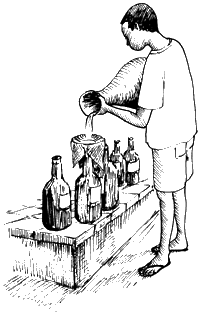COMPETITION WINNER
by Revd Francis King’ang’a.
African traditional salt or lye (uvusaaru) has been used for generations in our area of Western Kenya. In recent years it has been replaced by common table salt. Lye was used for cooking vegetables, soap-making and for some medicinal purposes. Older people believe that using lye for daily cooking helped people to live longer because of its medical benefits.
It is very easy to produce lye from all kinds of local vegetation. In this area we use mostly bean husks, maize husks, pawpaw leaves, grass and papyrus reeds – which have few other uses here.
The vegetation is cut and burnt while still green. The ashes are collected and kept in a large container. The ash is then mixed with rainwater in smaller containers and passed several times through clean cloths to remove the particles of dirt. The filtered liquid is stored either in large pots or plastic bottles. This liquid can also be heated at high temperature in pans and allowed to evaporate, leaving crystals of salt. The end product is thus either liquid salt in solution or crystals of salt.







